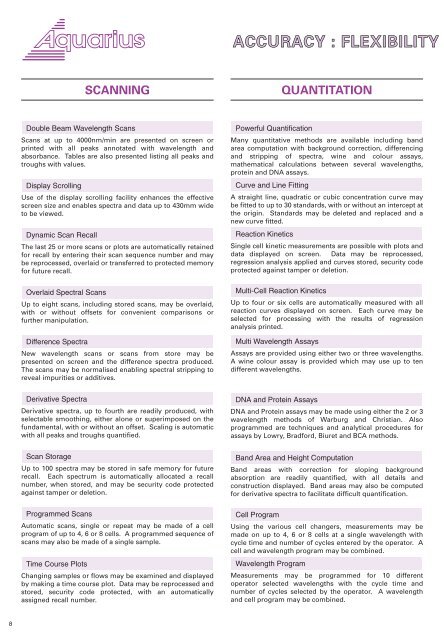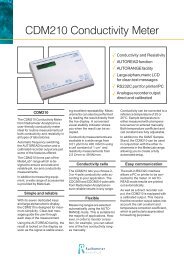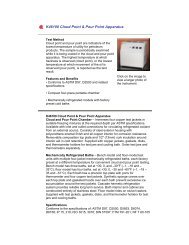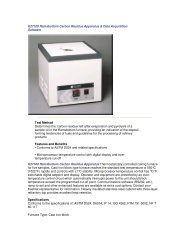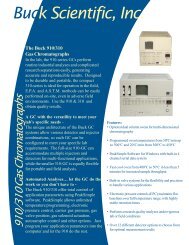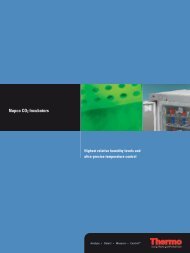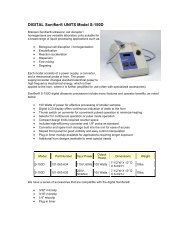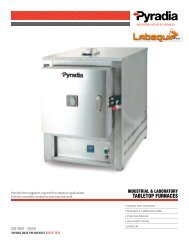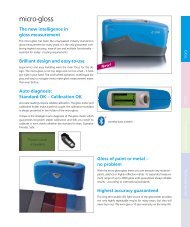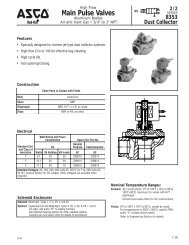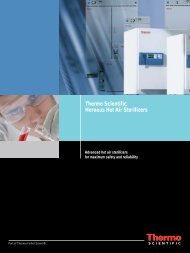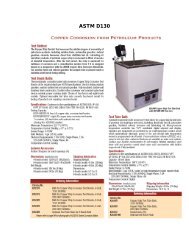CE 7000 Series.pdf
CE 7000 Series.pdf
CE 7000 Series.pdf
Create successful ePaper yourself
Turn your PDF publications into a flip-book with our unique Google optimized e-Paper software.
SUPERB VERSATILITY<br />
ACCURACY : FLEXIBILITY<br />
Scans at up to 4000nm/min are presented on screen or<br />
printed with all peaks annotated with wavelength and<br />
absorbance. Tables are also presented listing all peaks and<br />
troughs with values.<br />
Display Scrolling<br />
Use of the display scrolling facility enhances the effective<br />
screen size and enables spectra and data up to 430mm wide<br />
to be viewed.<br />
Dynamic Scan Recall<br />
The last 25 or more scans or plots are automatically retained<br />
for recall by entering their scan sequence number and may<br />
be reprocessed, overlaid or transferred to protected memory<br />
for future recall.<br />
Overlaid Spectral Scans<br />
Up to eight scans, including stored scans, may be overlaid,<br />
with or without offsets for convenient comparisons or<br />
further manipulation.<br />
Difference Spectra<br />
SCANNING<br />
Double Beam Wavelength Scans<br />
New wavelength scans or scans from store may be<br />
presented on screen and the difference spectra produced.<br />
The scans may be normalised enabling spectral stripping to<br />
reveal impurities or additives.<br />
FULL VALIDATION PRO<strong>CE</strong>D<br />
WIDEST AC<strong>CE</strong>SSORY RAN<br />
Powerful Quantification<br />
Many quantitative methods are available including band<br />
area computation with background correction, differencing<br />
and stripping of spectra, wine and colour assays,<br />
mathematical calculations between several wavelengths,<br />
protein and DNA assays.<br />
Curve and Line Fitting<br />
A straight line, quadratic or cubic concentration curve may<br />
be fitted to up to 30 standards, with or without an intercept at<br />
the origin. Standards may be deleted and replaced and a<br />
new curve fitted.<br />
Reaction Kinetics<br />
Single cell kinetic measurements are possible with plots and<br />
data displayed on screen. Data may be reprocessed,<br />
regression analysis applied and curves stored, security code<br />
protected against tamper or deletion.<br />
Up to four or six cells are automatically measured with all<br />
reaction curves displayed on screen. Each curve may be<br />
selected for processing with the results of regression<br />
analysis printed.<br />
Multi Wavelength Assays<br />
QUANTITATION<br />
Multi-Cell Reaction Kinetics<br />
Assays are provided using either two or three wavelengths.<br />
A wine colour assay is provided which may use up to ten<br />
different wavelengths.<br />
Derivative Spectra<br />
Derivative spectra, up to fourth are readily produced, with<br />
selectable smoothing, either alone or superimposed on the<br />
fundamental, with or without an offset. Scaling is automatic<br />
with all peaks and troughs quantified.<br />
DNA and Protein Assays<br />
DNA and Protein assays may be made using either the 2 or 3<br />
wavelength methods of Warburg and Christian. Also<br />
programmed are techniques and analytical procedures for<br />
assays by Lowry, Bradford, Biuret and BCA methods.<br />
Scan Storage<br />
Up to 100 spectra may be stored in safe memory for future<br />
recall. Each spectrum is automatically allocated a recall<br />
number, when stored, and may be security code protected<br />
against tamper or deletion.<br />
Band Area and Height Computation<br />
Band areas with correction for sloping background<br />
absorption are readily quantified, with all details and<br />
construction displayed. Band areas may also be computed<br />
for derivative spectra to facilitate difficult quantification.<br />
Programmed Scans<br />
Automatic scans, single or repeat may be made of a cell<br />
program of up to 4, 6 or 8 cells. A programmed sequence of<br />
scans may also be made of a single sample.<br />
Time Course Plots<br />
Changing samples or flows may be examined and displayed<br />
by making a time course plot. Data may be reprocessed and<br />
stored, security code protected, with an automatically<br />
assigned recall number.<br />
Cell Program<br />
Using the various cell changers, measurements may be<br />
made on up to 4, 6 or 8 cells at a single wavelength with<br />
cycle time and number of cycles entered by the operator. A<br />
cell and wavelength program may be combined.<br />
Wavelength Program<br />
Measurements may be programmed for 10 different<br />
operator selected wavelengths with the cycle time and<br />
number of cycles selected by the operator. A wavelength<br />
and cell program may be combined.<br />
8


